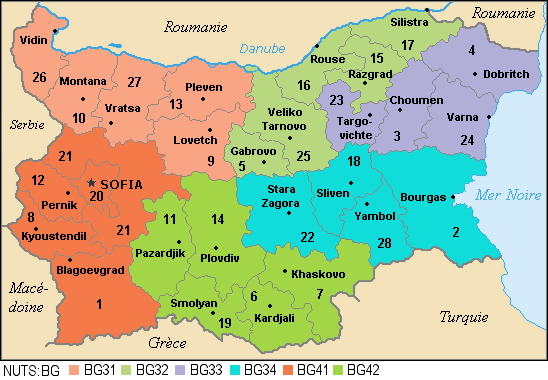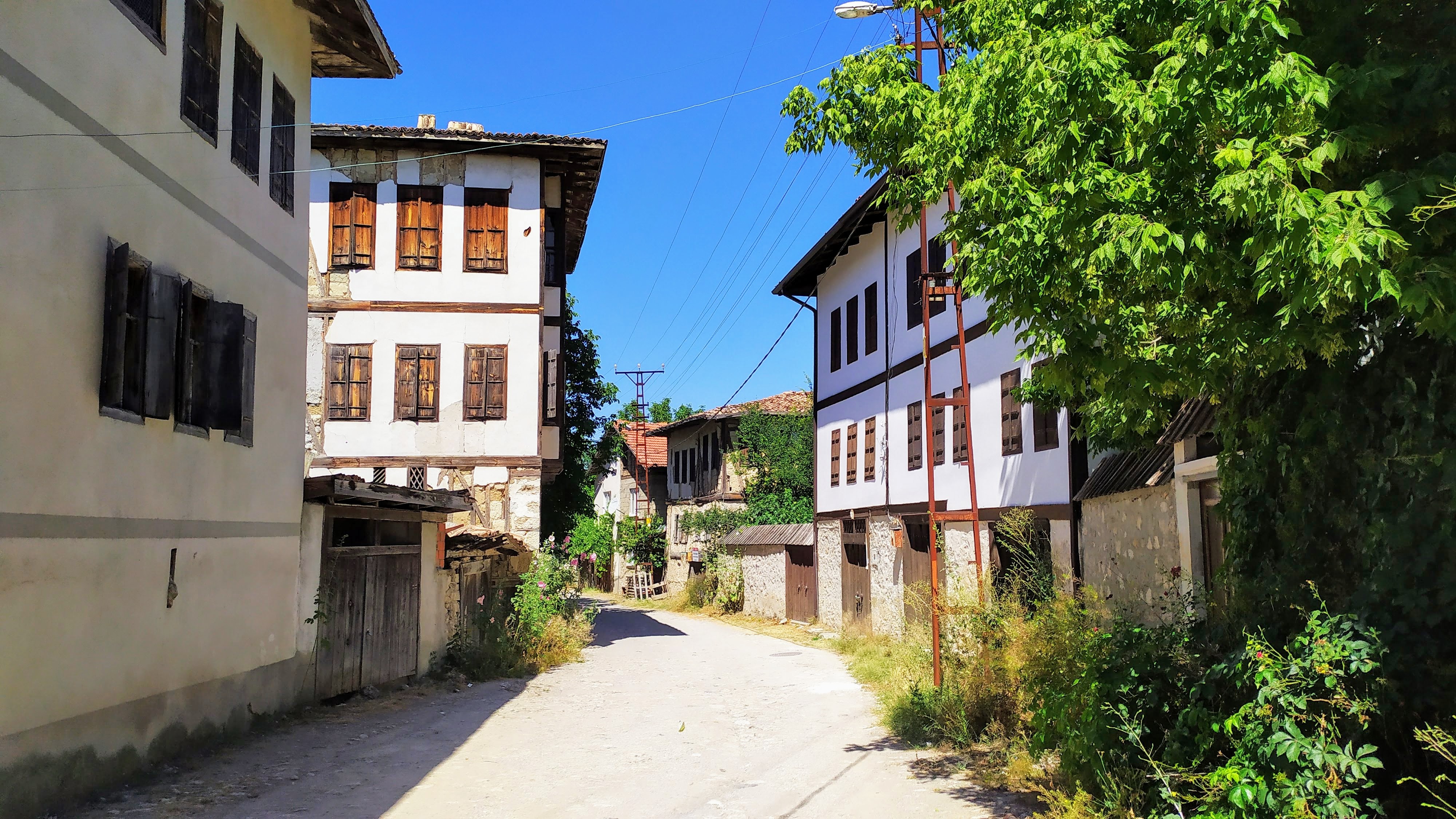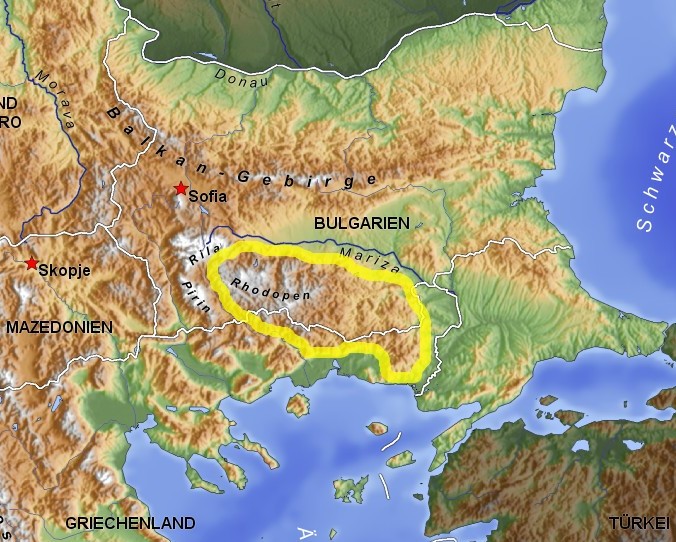|
Barutin
Barutin ( bg, Барутин) is a village in southwestern Bulgaria. It is located in the municipality of Dospat, Smolyan Province. Geography The village of Barutin is located in the Western Rhodope Mountains. It is situated in the Chech region. History From the middle of the 17th to the beginning of the 19th century the majority of the inhabitants of the village had Yörüks origins. They abandoned the village in the beginning of the 19th century and in the middle of the 19th century the majority of the inhabitants were Pomaks. During the April Uprising Ahmed aga Barutinliata led a campaign against Batak from this village. Religion The most population is Muslim. Most inhabitants of the village are Pomaks. Sights * Basilica from the 5–6th century. * Thracian The Thracians (; grc, Θρᾷκες ''Thrāikes''; la, Thraci) were an Indo-European speaking people who inhabited large parts of Eastern and Southeastern Europe in ancient history.. "The Thracian ... [...More Info...] [...Related Items...] OR: [Wikipedia] [Google] [Baidu] |
Dospat Municipality
The Dospat Municipality is a municipality in southwestern Bulgaria and is one of the municipalities in the Smolyan Province. Geography It covers the southwestern Rhodope Mountains. 8 settlements belong to the municipality with a total of 8217 in 2016. Demography The municipality of Dospat lost a large part of its population since the fall of communism in Bulgaria, due to emigration and more recently due to negative growth rate. As of 018, the municipality of Dospat had 7,932 inhabitants, down from 10,489 inhabitants in 1992. There were 64 children born in 2016, down from 91 compared to five years earlier. The number of deaths is 89 as of 2016, down from 105 in 2011. The natural population growth is minus 25 people, nearly double as many compared to minus 14 people in 2011. Religion Nearly half of the population did not answer the question on their religion; only a slight majority did answer the question. Of those people only 55 are Orthodox Christians, while the other p ... [...More Info...] [...Related Items...] OR: [Wikipedia] [Google] [Baidu] |
Provinces Of Bulgaria
The provinces of Bulgaria ( bg, области на България, oblasti na Bǎlgarija) are the first-level administrative subdivisions of the country. Since 1999, Bulgaria has been divided into 28 provinces ( bg, области, links=no – ''oblasti;'' singular: – '' oblast''; also translated as "regions") which correspond approximately to the 28 districts (in bg, links=no, окръг – '' okrǎg'', plural: – ''okrǎzi''), that existed before 1987. The provinces are further subdivided into 265 municipalities (singular: – '' obshtina'', plural: – ''obshtini''). Sofia – the capital city of Bulgaria and the largest settlement in the country – is the administrative centre of both Sofia Province and Sofia City Province (Sofia- grad). The capital is included (together with three other cities plus 34 villages) in Sofia Capital Municipality (over 90% of whose population lives in Sofia), which is the sole municipality comprising Sofia City province. Term ... [...More Info...] [...Related Items...] OR: [Wikipedia] [Google] [Baidu] |
Yörüks
The Yörüks, also Yuruks or Yorouks ( tr, Yörükler; , ''Youroúkoi''; bg, юруци; mk, Јуруци, ''Juruci''), are a Turkish ethnic subgroup of Oghuz descent, some of whom are nomadic, primarily inhabiting the mountains of Anatolia, and partly in the Balkan peninsula. On the Balkans Yörüks are distributed over a wide area from southern Serbia, parts of Bulgaria, north to Larissa in Thessaly and southern Thrace.Svanberg, Ingvar: The turkish-speaking ethnic groups in Europe (pp.65-128) iEuropa ethnica, volume 41 W. Braumüller, 1984, p.68. Their name derives from the Turkish verb yürü- (''yürümek'' in infinitive), which means "to walk", with the word ''yörük'' or ''yürük'' designating "those who walk on the hindlegs, walkers". The Yörüks were under the Yörük Sanjak, ( tr, Yörük Sancağı) which was not a territorial unit like the other sanjaks, but a separate organisational unit of the Ottoman Empire. According to some, those tribes residing in the east ... [...More Info...] [...Related Items...] OR: [Wikipedia] [Google] [Baidu] |
Thrace
Thrace (; el, Θράκη, Thráki; bg, Тракия, Trakiya; tr, Trakya) or Thrake is a geographical and historical region in Southeast Europe, now split among Bulgaria, Greece, and Turkey, which is bounded by the Balkan Mountains to the north, the Aegean Sea to the south, and the Black Sea to the east. It comprises southeastern Bulgaria ( Northern Thrace), northeastern Greece (Western Thrace), and the European part of Turkey (East Thrace). The region's boundaries are based on that of the Roman Province of Thrace; the lands inhabited by the ancient Thracians extended in the north to modern-day Northern Bulgaria and Romania and to the west into the region of Macedonia. Etymology The word ''Thrace'' was first used by the Greeks when referring to the Thracian tribes, from ancient Greek Thrake (Θρᾴκη), descending from ''Thrāix'' (Θρᾷξ). It referred originally to the Thracians, an ancient people inhabiting Southeast Europe. The name ''Europe'' first referred ... [...More Info...] [...Related Items...] OR: [Wikipedia] [Google] [Baidu] |
Basilica
In Ancient Roman architecture, a basilica is a large public building with multiple functions, typically built alongside the town's forum. The basilica was in the Latin West equivalent to a stoa in the Greek East. The building gave its name to the architectural form of the basilica. Originally, a basilica was an ancient Roman public building, where courts were held, as well as serving other official and public functions. Basilicas are typically rectangular buildings with a central nave flanked by two or more longitudinal aisles, with the roof at two levels, being higher in the centre over the nave to admit a clerestory and lower over the side-aisles. An apse at one end, or less frequently at both ends or on the side, usually contained the raised tribunal occupied by the Roman magistrates. The basilica was centrally located in every Roman town, usually adjacent to the forum and often opposite a temple in imperial-era forums. Basilicas were also built in private residences ... [...More Info...] [...Related Items...] OR: [Wikipedia] [Google] [Baidu] |
Batak, Bulgaria
Batak ( bg, Батак ) is a town in Pazardzhik Province, Southern Bulgaria, not far from the town of Peshtera. It is the administrative centre of the homonymous Batak Municipality. As of December 2009, the town has a population of 3,498 inhabitants.Bulgarian National Statistical Institute - towns in 2009 Geography Batak is situated in the northwestern slopes of the , at 1036 m above sea level. It is surrounded by many peaks, clad with century-old pine and spruce forests. The climate is temperate continental with a characteristic southern warm wind. Batak was pronounced town in 1964 and has a p ...[...More Info...] [...Related Items...] OR: [Wikipedia] [Google] [Baidu] |
Ahmed Aga Barutinliata
Ahmad ( ar, أحمد, ʾAḥmad) is an Arabic male given name common in most parts of the Muslim world. Other spellings of the name include Ahmed and Ahmet. Etymology The word derives from the root (ḥ-m-d), from the Arabic (), from the verb (''ḥameda'', "to thank or to praise"), non-past participle (). Lexicology As an Arabic name, it has its origins in a Quranic prophecy attributed to Jesus in the Quran which most Islamic scholars concede is about Muhammad. It also shares the same roots as Mahmud, Muhammad and Hamed. In its transliteration, the name has one of the highest number of spelling variations in the world. Though Islamic scholars attribute the name Ahmed to Muhammed, the verse itself is about a Messenger named Ahmed, whilst Muhammed was a Messenger-Prophet. Some Islamic traditions view the name Ahmad as another given name of Muhammad at birth by his mother, considered by Muslims to be the more esoteric name of Muhammad and central to understanding his ... [...More Info...] [...Related Items...] OR: [Wikipedia] [Google] [Baidu] |
April Uprising
The April Uprising ( bg, Априлско въстание, Aprilsko vastanie) was an insurrection organised by the Bulgarians in the Ottoman Empire from April to May 1876. The regular Ottoman Army and irregular bashi-bazouk units brutally suppressed the rebels, resulting in a public outcry in Europe, with many famous intellectuals condemning the atrocities—labelled the Bulgarian Horrors or Bulgarian atrocities—by the Ottomans and supporting the oppressed Bulgarian population. This outrage was key for the re-establishment of Bulgaria in 1878. The 1876 uprising involved only those parts of the Ottoman territories populated predominantly by Bulgarians. The emergence of Bulgarian national sentiments was closely related to the re-establishment of the independent Bulgarian Orthodox Church in 1870. Background In Europe, in the 18th century, the classic non-national states were the '' multi-ethnic empires'' such as the Ottoman Empire and the Austro-Hungarian Empire, whose ... [...More Info...] [...Related Items...] OR: [Wikipedia] [Google] [Baidu] |
Pomaks
Pomaks ( bg, Помаци, Pomatsi; el, Πομάκοι, Pomáki; tr, Pomaklar) are Bulgarian-speaking Muslims inhabiting northwestern Turkey, Bulgaria and northeastern Greece. The c. 220,000 strong ethno-confessional minority in Bulgaria is recognized officially as Bulgarian Muslims by the government. The term has also been used as a wider designation, including also the Slavic Muslim populations of North Macedonia and Albania. Most Pomaks today live in Turkey where they have settled as muhacirs as a result of escaping previous ethnic cleansing in Bulgaria. Bulgaria recognizes their language as a Bulgarian dialect whereas in Greece and Turkey they self-declare their language as the Pomak language. The community in Greece is commonly fluent in Greek, and in Turkey, Turkish, while the communities in these two countries, especially in Turkey, are increasingly adopting Turkish as their first language as a result of education and family links with the Turkish people. They ... [...More Info...] [...Related Items...] OR: [Wikipedia] [Google] [Baidu] |
Chech (region)
Chech ( bg, Чеч, el, Τσέτσι) or Chechko ( bg, Чечко) is a geographical and historical region of the Balkan peninsula in southeastern Europe in modern-day Bulgaria and Greece. It consists of about 60 settlements and was traditionally mostly Pomak with an Eastern Orthodox Church, Orthodox Greeks, Greek and Bulgarians, Bulgarian minorities. The Chech region is situated on the border of the much larger regions of Macedonia (region), Macedonia and Thrace. It covers the western Rhodope Mountains and the northern slopes of Falakro ( bg, Боздаг, ''Bozdag''). It is divided in two: ''Drama Chech'' and ''Nevrokopi Chech''. The first one and partially the second one is in Greece Greece,, or , romanized: ', officially the Hellenic Republic, is a country in Southeast Europe. It is situated on the southern tip of the Balkans, and is located at the crossroads of Europe, Asia, and Africa. Greece shares land borders wit .... According to Vasil Kanchov the eastern bor ... [...More Info...] [...Related Items...] OR: [Wikipedia] [Google] [Baidu] |
Smolyan Province
Smolyan Province ( bg, Област Смолян, ''Oblast Smolyan''; former name Smolyan okrug) is a province in Southern-central Bulgaria, located in the Rhodope Mountains, neighbouring Greece to the south. It is named after its administrative and industrial centre — the city of Smolyan. The province embraces a territory of .Bulgarian Provinces area and population 1999 — National Center for Regional Development — page 90-91 that is divided into 10 municipalities with a total population of 124,795 inhabitants, as of December 2009. [...More Info...] [...Related Items...] OR: [Wikipedia] [Google] [Baidu] |
Rhodope Mountains
The Rhodopes (; bg, Родопи, ; el, Ροδόπη, ''Rodopi''; tr, Rodoplar) are a mountain range in Southeastern Europe, and the largest by area in Bulgaria, with over 83% of its area in the southern part of the country and the remainder in Greece. Golyam Perelik is its highest peak at . The mountain range gives its name to the terrestrial ecoregion Rodope montane mixed forests that belongs in the temperate broadleaf and mixed forests biome and the Palearctic realm. The region is particularly notable for its karst areas with their deep river gorges, large caves and specific sculptured forms, such as the Trigrad Gorge. A significant part of Bulgaria's hydropower resources are located in the western areas of the range. There are a number of hydro-cascades and dams used for electricity production, irrigation, and as tourist destinations. In Greece, there are also the hydroelectric power plants of Thisavros and Platanovrysi. The Rhodopes have a rich cultural heritage includ ... [...More Info...] [...Related Items...] OR: [Wikipedia] [Google] [Baidu] |






